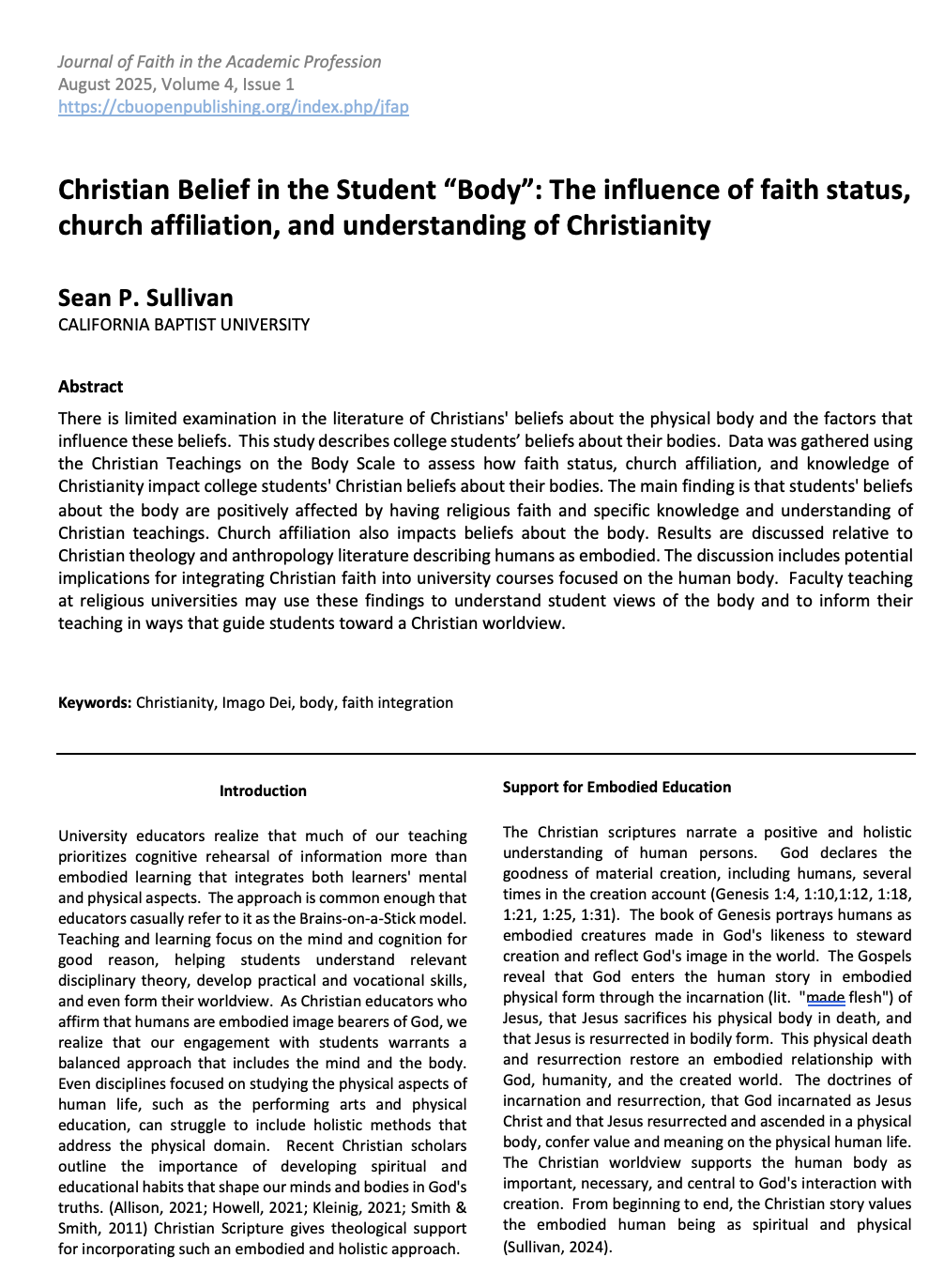Christian Belief in the Student "Body": The influence of religious faith status, church affiliation, and theological knowledge
Keywords:
Christian identity, views of body, faith integrationAbstract
This study aimed to describe the influence of religious identity on college student views of their bodies. Data was gathered using the Christian Teachings on the Body Scale to assess how faith status, church affiliation, and knowledge of Christianity impact college students' Christian beliefs about their bodies. The main finding is that student beliefs about the body are positively affected by having religious faith and specific knowledge and understanding of Christian teachings. Church affiliation also impacts belief about the body. Results are discussed relative to Christian theology and anthropology literature describing humans as embodied. The potential implications for integrating Christian faith into university courses in health-related disciplines are also discussed. Faculty teaching at religious universities may use these findings to understand student views of the body and guide students toward Christian views that enhance personal wellness and professional development as image bearers.
References
Allison, G. R. (2021). Embodied: living as whole people in a fractured world. Baker Books.
Bynum, Caroline Walker. (1995). The Resurrection of the Body in Western Christianity, 200–1336. New York: Columbia University Press.
Forstmann, M., Burgmer, P., & Mussweiler, T. (2012). “The mind is willing, but the flesh is weak” The effects of mind-body dualism on health behavior. Psychological science, 23(10), 1239-1245.
Glanzer, P. (2024): June 17. Stewarding Our Bodies: Less Than a Dozen Christian Colleges Give Catalogue Evidence of Teaching Health and Human Performance Gen Eds Christianly. https://christianscholars.com/stewarding-our-bodies-less-than-a-dozen-christian-colleges-give-catalogue-evidence-of-teaching-health-and-human-performance-christianly/
Hochstetler, Douglas, Peter Hopsicker, and R. Scott Kretchmar. (2008). “The Ambiguity of Embodiment and Sport: Overcoming Theological Dichotomies.” In The Image of God in the Human Body: Essays on Christianity and Sports, edited by D. Deardorff and John White, 61–78. Lewiston, NY: Edwin Mellen Press.
Hoffman, Shirl. (2010). Good Game: Christianity and the Culture of Sports. Waco, TX: Baylor University Press.
Howell, B. (2021): November 10. Teaching Bodies: How to bring the body into Christian liberal arts. https://christianscholars.com/teaching-bodies-how-to-bring-the-body-into-the-christian-liberal-arts/
Jacobson HL, Hall ME, Anderson TL, Willingham MM. (2016). Temple or Prison: Religious Beliefs and Attitudes Toward the Body. J Relig Health. Dec;55(6):2154-73. https://doi.org/10.1007/s10943-016-0266-z. PMID: 27283045.
Kelly, Patrick. (2012). Catholic Perspectives on Sports: From Medieval to Modern Times. Mahwah, NJ: Paulist Press.
Kleinig, J. W. (2021). Wonderfully made: a Protestant theology of the body. Lexham Press.
Knabb, J., Pate, R, Sullivan, S, Salley, E, Miller, A, & Boyer, W. (2020): “Walking with God”: developing and pilot testing a manualised four-week program combining Christian meditation and light-to-moderate physical activity for daily stress, Mental Health, Religion & Culture, https://doi.org/10.1080/13674676.2020.1819221.
Knabb, J., & Wang, K. (2019). The Communion with God Scale: Shifting from an etic to emic perspective to assess fellowshipping with the Triune God. Psychology of Religion and Spirituality. Advance online publication. https://doi.org/10.1037/rel0000272
Li, S., Stampfer, M. J., Williams, D. R., & VanderWeele, T. J. (2016). Association of religious service attendance with mortality among women. JAMA internal medicine, 176(6), 777-785.
Mahoney, A., Carels, R. A., Pargament, K. I., Wachholtz, A., Edwards Leeper, L., Kaplar, M., & Frutchey, R. (2005). " The Sanctification of the Body and Behavioral Health Patterns of College Students". The International Journal for the Psychology of Religion, 15(3), 221-238.
Nehrbass, K. (2022). Taking the “fear factor” out of Faith Integration: Four main “entry points”. Journal of Faith in the Academic Profession, 1(1), 14-24.
Pew Research Center. Religious landscape study: college graduates. (2014). https://www.pewresearch.org/religion/relig ious-landscape-study/educational-distribution/college/
PRRI. Religion and congregations in a time of social and political upheaval: findings from the 2022 Health of Congregations Survey. (2023). https://www.prri.org/research/religion-and- congregations-in-a-time-of-social-and-political-upheaval/
Shang, Y., Xie, H. D., & Yang, S. Y. (2021). The relationship between physical exercise and subjective well-being in college students: The mediating effect of body image and self-esteem. Frontiers in Psychology, 12, 658935.
Smith, D., & Smith, J. K. (Eds.). (2011). Teaching and Christian practices: Reshaping faith and learning. Wm. B. Eerdmans Publishing.
Sullivan, S. P., & Barnes, J. (2024). Inspired anatomy education: Might God be relevant? Anatomical Sciences Education. https://doi.org/10.1002/ase.2408
Sullivan, S. (2019). Single, separate, or unified? Exploring Christian academicians’ views of the body, sport and religious experience, Sport in Society. 22(2). https://doi: 10.1080/17430437.2017.1360584

Downloads
Published
Issue
Section
License
Copyright (c) 2025 Sean Sullivan (Author)

This work is licensed under a Creative Commons Attribution-NonCommercial-NoDerivatives 4.0 International License.


